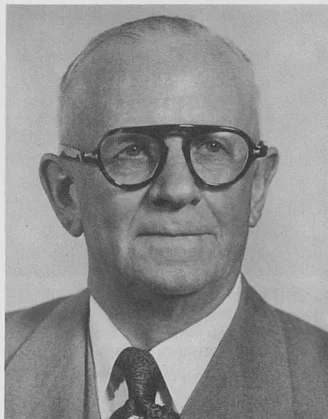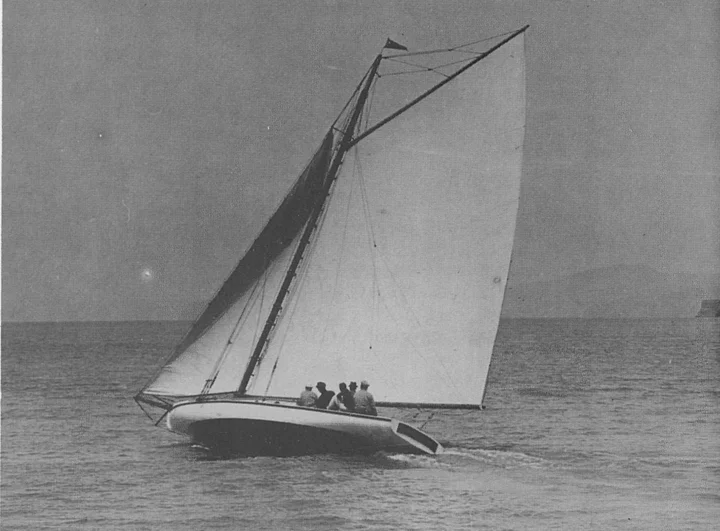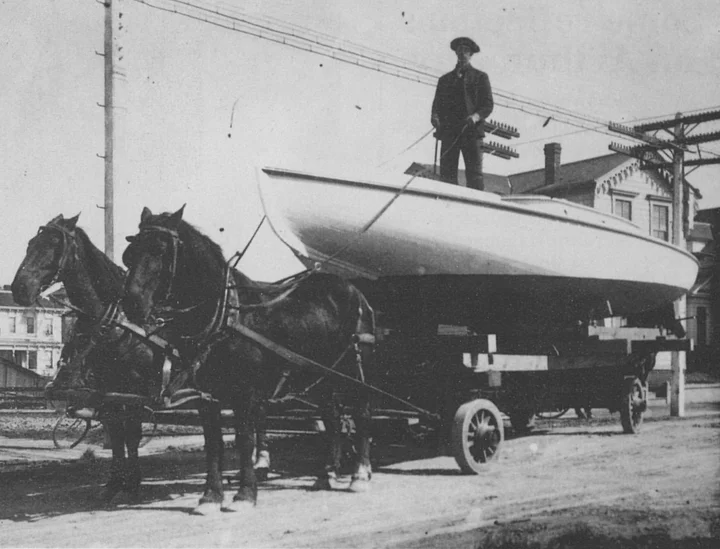Incidentally, in order that I may qualify myself as one knowledgeable of many changes, as Eureka has developed over the years, I might tell of my own background. I was born in Eureka on the 5th day of March, A.D. 1879. My birthplace was in the William Brett cottage located on the southwest corner of 5th and D streets. My mother’s maiden name was Emily Pengilly Way and my father was Henry Way. Mother was a native of England where she lived and was a pupil teacher at Weymouth until she came to this country.
— Arthur W. Way
The above information is from the beginning notes for a talk that the late Arthur Way prepared many years ago. He had been called upon to speak before numerous groups including the Historical Society, meetings that were held in Eureka and at Mattole. I feel fortunate to have shared in reviewing these thoughts used in his preparation to entertain at a function the majority of us were unable to attend.
Arthur W. Way, one of their three children, was born March 5, 1879. His mother gave him his elementary school education. He mentioned playing ball in passing, but not many know that he was a star football and baseball player when he attended Winship High School. It was some time after his graduation from Winship that he took up the study of law and passed the Bar examination.
Following his death the newspapers said: “There are not many who ever heard of the other Arthur W. Way—the intrepid sportsman, the athlete, the volunteer fireman, the attorney who for years fought for the causes of the Indians, the champion yachtman who for more than a half century set a record which has never been broken.”
When he was 37 years of age, he accomplished an almost impossible task of salvaging most of the cargo, ship’s gear, and equipment that was aboard the S.S. Bear, the wrecked steamer off Cape Mendocino on June 14, 1916.
The area is not readily accessible today, but was almost impossible to reach at that time. Arthur and his crews built temporary roads and bridges and laid railroad ties down the beach placing them not more than four feet apart. They used the funnels from the Bear for culverts at several streams. It made for a rough bumpy road but served the purpose.
He sent to Switzerland for three narrow-gauge trucks to bring the salvage to Ferndale, and used 35 four-horse teams around the clock to accomplish the task which even the insurers felt couldn’t be done. It was acclaimed at that time as the greatest engineering and salvage job of its kind in the world.
The Oreades shows its speed in this run on San Francisco Bay.
In the yacht Oreades, which he and William S. Clark built on Humboldt Bay with no previous knowledge of boat building. Way and an Eureka crew entered the San Francisco Bay Regatta. On that day. May 25, 1913, the San Francisco Yacht Club saw the visitors make a clean sweep, taking the perpetual trophy away. This was a trophy San Francisco Yacht Club had held for 34 years and one that had never left the San Francisco Bay area in its existence of 85 years. It is noteworthy what the newspapers said in their reporting of Art Way’s achievement: “It is typical of the man that he always gave full credit to his crew for the astounding victory over the cream of the yacht fleet at San Francisco.”
And so to keep faith, let us look at that crew of the Oreades: Art Way was Skipper, with him were, H.L. “Toppy” Ricks, William S. Clark, R.J. Kellen, Bernard B. Bartlett and William Kressman. All were members of the Eureka’s Sequoia Yacht Club. Today the Humboldt Bay Maritime Museum has a display of some of Arthur W. Way’s cups and memorabilia.
Before going to another subject, what was the background for this dramatic takeover? The story of the Oreades’ origin is almost as fantastic as some of the other events in the Way saga.
It was two years before the great race. Way and his close friend, W.S. Clark, had heard of a beautiful yacht — a 35 footer which had won the Great Lakes Championship against supposedly superior craft.
They sent east to the Small Brothers for the plans, which cost them $135 — a whale of amount of money in those days. Neither one of them had ever built a boat before.
Clark had a good-sized shed at his home at Whipple (14th) & C sts. When the plans arrived. Way rolled them open on the shed floor and Clark figured them out.
They started to work — on two vessels. Clark named his twin of Art’s the “Calypso.”
Only the mast and spars were farmed out, to be shaped from native Humboldt fir. The rest, Way and Clark did themselves. There was one hitch that was a cartoonist’s classic: When their neat, trim crafts were completed, they were too big to get out of the shed. One end of the building had to be knocked out to release the boats.
Cochrane’s Team and Dray hauled the Oreades from its building site to a launching in the bay at the foot of C Street. The driver in this 1908 photo is George Cochrane.
Then they needed help so Cochrane’s dray came to move them to the foot of C Street where Mercer Fraser had a piledriver. Its rigging was used to launch the two boats. The Way boat was christened “Oreades” (named for a Greek sea nymph).
Then the fun began. The two fellows were the best of friends — anywhere except at the tiller. There writers said, they showed “tooth and fang.” Way once recalling race experiences said, “I could beat her (the Calypso) by 14 seconds in seven miles every time.” He had the “feel” and the “knowhow.”
So after much local practice, the San Francisco race of May 25, 1913, was entered and arrangements were made to ship the boat to San Francisco aboard the S.S. Vanguard.
The day of the race the last survivors in the eliminations were the two boats, the San Francisco yacht “Challenger” and Way’s “Oreades.”
Over a hundred boats were entered and there had been much more wind than they needed. It was nip-and-tuck in the stretch. They were on the last lap and rounding the stake boat. Under the strain of the terrific wind the turnbuckle holding the “Challenger’s” bowsprit, which in turn held the mainmast guy, broke and down came mast and canvas.
On the “Oreades,” at the same time, it called for every ounce of strength and every shred of experience. Kellen was the mainsheet man, and Bartlett handled the jib and was in charge of the balloon spinnaker and water-sail, if needed. Now the whole object was to prevent the loss of her own sticks. Skipper Way controlled the tiller with an unbelievable smoothness and she breezed across the finish line — and to the championship — intact. San Francisco papers blazed the story across their front pages.
Arthur Way was very modest but at the same time ecstatic. He said, “Teamwork won it,” and stuck with this remark for years and years after. However all present at the event attested to the superior seamanship of Arthur W. Way, skipper of the Oreades.
It is a fact there are other little-known “firsts” during his long career. An example, the first motor truck to reach Bridgeville was driven by Arthur W. Way.
Arthur is credited with being the key person on forming the Sequoia Yacht Club and constructing its spacious, imposing building on Günther Island.
In 1916 Arthur Way purchased 30 some acres near the mouth of the Mattole River, southeast of Ferndale. There he initiated, and carried out each Fourth of July what developed into a huge celebration in honor of his small daughter, Dorothy. Today she still remembers the many big metal containers of ice cream that he transported for the event. He spent large sums for the picnic and fireworks. The celebration was free for all who would attend.
Now of course the Mattole Grange has been the sponsor of the Annual Fourth of July Celebrations and other picnics, dances, barbecues, etc. It was on October, 1961, that the Mattole Grange honored Arthur by having a “Way Day.” Invitations were extended all over the country to have his friends attend the picnic. It was a time when speeches were heard from the late Frank P. Belotti, as the main speaker and Martha B. Roscoe as M.C., but most important was the opportunity for people to express their appreciation and congratulations to Arthur, honoring him on his 82nd birthday. And some came to say thanks for the trucks he sent to flooded country in 1955 to help people, or for personally planting fish in some streams long before the state took over or for the setting aside of Ferndale’s streams for children’s fishing only and he fostered many other worthwhile projects. Yes, “Way Park” at Mattole is named in his honor.
For two terms he served the City of Eureka as its mayor. (Emily Jones succeeded him in that office.) Years later he entered the political arena of the State of California. He was sent to the California Assembly, from the First District in 1948 and after serving that year and 1949 he was selected for the State Senate where he served from 1950 to 1956.
Those who know, credit him with taking an active role in highway development. He gave top priority to both the development of Highway 1 from San Francisco north to Oregon and the improvement of Redwood Highway. The Redwood Highway Association acknowledges that he was one of the earliest proponents for the shoreline highway and took an active roll in many matters of their Association.
Arthur Way and the late Richard Denboe are credited with starting the Annual Crab Feed still held in Sacramento by Humboldters.
He was the founder and owner-operator of the former Redwood Empire Freight Lines and was the first to bring a refrigeration truck to the area. He operated several trucks regularly between San Francisco and Eureka. Way’s Garage was located at 7th & D streets. In earlier years he was a partner in the auto sales firm known as Mercer- Way. Some of the autos they sold and serviced were Lozier, Chalmers, Flanders, Hupmobile and Studebaker and they also had International and Mack trucks.
When he was president of a men’s club, known as “Knights of the Roundtable” he proposed they start a youth club, “perhaps at the high school, the men could act as advisors and direct the youths in looking for places to serve, etc.” The club known as Excalibur came into being and the idea quickly caught on in other cities. This was the forerunner of the Interact and Key clubs sponsored by Rotary and Kiwanis service clubs today.
###
The story above was excerpted from an article originally printed in the July-August 1988 issue of the Humboldt Historian, a journal of the Humboldt County Historical Society. It is reprinted here with permission. The Humboldt County Historical Society is a nonprofit organization devoted to archiving, preserving and sharing Humboldt County’s rich history. You can become a member and receive a year’s worth of new issues of The Humboldt Historian at this link.



CLICK TO MANAGE